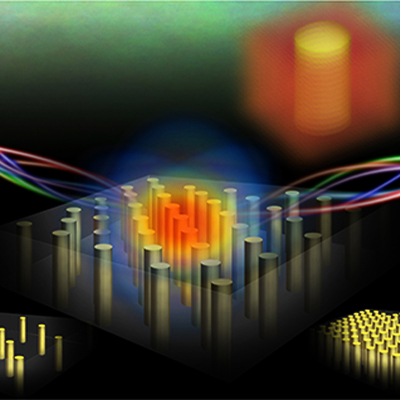
Researchers invent a new single-step approach to constructing electromagnetic metamaterials uses tiny self-assembled pillars in composite films.
Scientific Achievement: Demonstrated a one-step, direct growth of self-assembled nanocomposites for fabricating metamaterials as an advantageous and completely different approach when compared with previous methods.
Significance and Impact: Self-assembled nanocomposites open unprecedented possibilities for the development of nanoscale photonic materials and enhance light-matter interactions at the nanoscale level for novel applications such as super-resolution imaging (hyperlenses), cloaking, and hyperbolic propagation.
Publication: L. Li, L. Sun, J. S. Gomez-Diaz, N. L. Hogan, P. Lu, F. Khatkhatay, W. Zhang, J. Jian, J. Huang, Q. Su, M. Fan, C. Jacob, J. Li, X. Zhang, Q. X. Jia, M. Sheldon, A. Alu, X. Li, and H. Wang, "Changing the Nature of Optics in One Step." Nano Lett., 2016, 16, 3936.
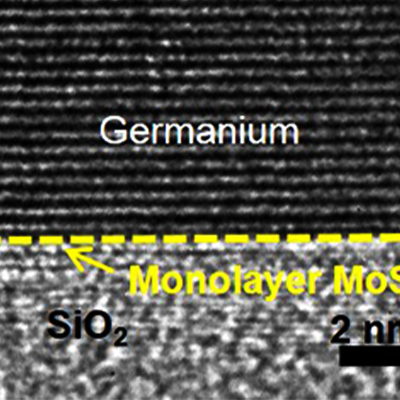
Scientific Achievement: Heterostructuring germanium (Ge) thin film and atomically thin molybdenum disulfide (MoS2) delivers novel characteristics distinguished from those of Ge and MoS2.
Significance: The novel heterostructure composed of conventional materials and two-dimensional (2D) materials provides novel ways of controlling physical properties of 2D materials and preparing crystalline building blocks for flexible devices.
Publication: Yung-Chen Lin, Ismail Bilgin, Towfiq Ahmed, Renjie Chen, Doug Pete, Swastik Kar, Jian-Xin Zhu, Gautam Gupta, Aditya Mohite, Jinkyoung Yoo, "Charge transfer in crystalline germanium/monolayer MoS2 heterostructures prepared by chemical vapor deposition." Nanoscale, 2016, 8, 18675, DOI: 10.1039/C6NR03621J.

Scientific Achievement: Using broken symmetry concepts, we created all-dielectric metasurfaces based on semiconductors that show record high quality factors (Q~600).
Significance: Among the highest Q resonances for metasurfaces using a relatively simple design. These Fano metasurfaces could lead to new types of optical devices such as nanolasers, detectors, modulators and sources of entangled photons.
Publication: Salvatore Campione, Sheng Liu, Lorena I. Basilio, Larry K. Warne, William L. Langston, Ting S. Luk, Joel R. Wendt, John L. Reno, Gordon A. Keeler, Igal Brener, and Michael B. Sinclair, "Broken Symmetry Dielectric Resonators for High Quality Factor Fano Metasurfaces." ACS Photonics 2016, 3 (12), pp 2362–2367, DOI: 10.1021/acsphotonics.6b00556.
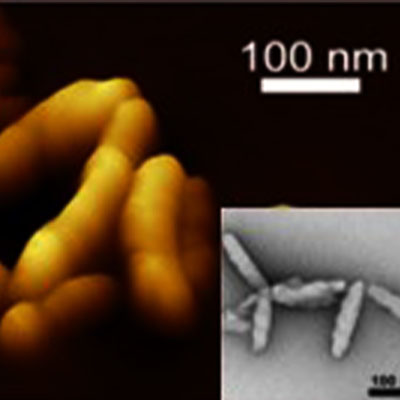
Scientific Achievement: An artificial light-harvesting (LH) system composed of block copolymer-based membrane nanocomposites demonstrates three-dimensional, supramolecular energy transfer. The system structurally and functionally mimics green bacterial LH systems.
Significance: Supramolecular energy transfer is realized using solution-processable polymer membrane materials via self-assembly. Artificial polymer-based LH system exhibits advantages to biological LH systems, namely; control of composition, flexibility and stability while maintaining bio-like efficiency.
Publications: Collins, A.M.Timin, J.A., Anthony, S.M. and Montaño, G.A. "Amphiphilic block copolymers as flexible membrane materials generating structural and functional mimics of green bacterial antenna complexes." (2016) Nanoscale, 8:15056-15063.
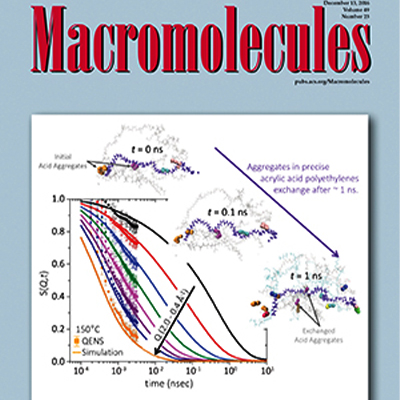
Scientific Achievement: Atomistic molecular dynamics simulations and quasi-elastic neutron scattering showed that dynamics in acid-containing polymers are heterogeneous, and that acid clusters exchange acid groups on the 1 ns time scale.
Significance: This study revealed the life time of acid clusters within the polymer matrix. Knowledge of the cluster life time, which controls the transport, mechanical, and viscoelastic properties of polymers with associating groups, will guide future design of these polymers.
Publication: L. R. Middleton, J. D. Tarver, J. Cordaro, M. Tyagi, C. L. Soles, A. L. Frischknecht, and K. I. Winey, “Heterogeneous Chain Dynamics and Aggregate Lifetimes in Precise Acid-Containing Polyethylenes: Experiments and Simulations,” Macromolecules, 2016, 49, 9176, DOI: 10.1021/acs.macromol.6b01918.

Scientific Achievement: Observed an order of magnitude increase in ionic conductivity in a tunable, strained nanocomposite by varying the type of rare-earth (RE) metal-oxides in the nanoscaffold films.
Significance: Materials with tunable and fast ion-transport (high ionic-conductivity) have applications in energy materials and devices, such as solid oxide fuel cells, sensors, and data storage since they provide high efficiency.
Publication: S. Lee, W. Zhang, F. Khatkhatay, Q. X. Jia, H. Wang, and J. L. MacManus-Driscoll, Adv. Funct. Mater., 25, 4328 (2015).
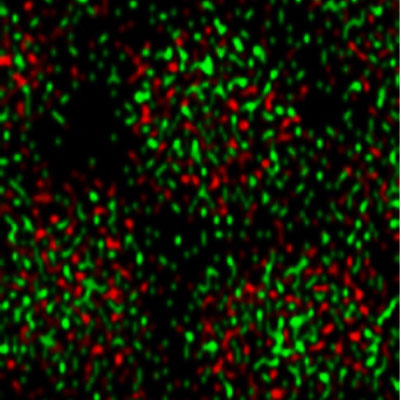
Scientific Achievement: Achieved previously elusive alloying of germanium with a high concentration of tin (as high as 42%) at the nanoscale level using a new synthetic approach and tested its light absorption properties.
Significance: The inefficient light absorption of germanium and silicon complicates their use in photovoltaic applications (solar energy capture), but it is significantly improved by adding tin. Nanoalloys of germanium and tin are also a potential replacement for pure germanium as an electrode material in lithium battery cells because germanium is brittle.
Publication: K. Ramasamy, P. G. Kotula, A. F. Fidler, M. T. Brumbach, J. M. Pietryga, and S. A. Ivanov, Chem. Mater. 27, 4640 (2015).

Scientific Achievement: A combined experimental and computational study of energy transfer reveals the relationship between electronic and nuclear forces during light-harvesting processes in dendrimers, a synthetic light-harvesting molecule that can be used in optical-electronic applications.
Significance: Dendrimers contain chromophores and have enormous potential for achieving efficient light capture and transport. This study helps develop improved organic photovoltaics and other solar energy conversion technologies with a new type of dendrimer.
Publication: J. F. Galindo, E. Atas, A. Altan, D. G. Kuroda, S. Fernandez-Alberti, S. Tretiak, V. Kleiman, and A. E. Roitberg, J. Am. Chem. Soc. 137, 11637 (2015).

Scientific Achievement: Theoretical and experimental methods were used to create different MoS2 structures, a catalyst for artificial photosynthesis and hydrogen (H2) fuel production. Both methods revealed that the octahedral structure (1T′ phase) of MoS2 enhances H2 yields by four-fold compared with other MoS2 structures.
Significance: The 1T′ phase of MoS2 is energetically favorable for a catalytic reaction that produces H2. Using this phase as a catalyst produced the highest amount of H2 yet reported for MoS2. High-yielding H2 production is vital toward developing hydrogen fuels that use only solar energy and water (clean energy).
Publication: S. S. Chou, N. Sai, P. Lu, E. N. Coker, S. Liu, K. Artyushkova, T. S. Luk, B. Kaehr, and C. J. Brinker, Nat. Comm., 6, 8311 (2015).

Scientific Achievement: A study explains how the competition between diffusion and collision processes of electron-hole pairs (excitons) affects single-photon generation in carbon nanotubes.
Significance: Reveals guiding principles toward using carbon nanotubes as single-photon sources in eavesdropping-proof quantum communication.
Publications: X. Ma, O. Roslyak, J. G. Duque, X. Pang, S. K. Doorn, A. Piryatinski, D. H. Dunlap, and H. Htoon, “Influences of Exciton Diffusion and Exciton-Exciton Annihilationon Photon Emission Statistics of Carbon Nanotubes,” Phys. Rev. Lett. 115, 01741 (2015).

Scientific Achievement: The radiative emission from a semiconductor quantum dot can be enhanced by plasmonic field interactions with a nearby metal antenna while keeping the non-radiative loss constant.
Significance: A plasmonic antenna can be used to enhance the emission of two-exciton states for photon-pair generation and plasmon-assisted lasing.
Publications: F. Wang, N.S. Karan, H.M. Nguyen, Y. Ghosh, C.J. Sheehan, J.A. Hollingsworth, and H. Htoon. Nanoscale 7 , 9387 (2015).
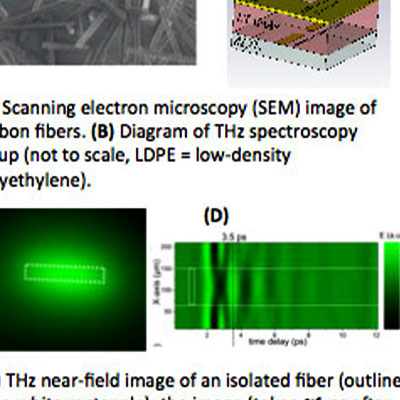
Scientific Achievement: Terahertz (THz) spectroscopy and imaging measured the resonances of individual, conductive carbon microfibers. Each microfiber “rings” (resonates) at a specific THz frequency.
Significance: Electrical conductivity is analyzed in individual carbon microfibers using THz spectroscopy. This technique is useful for measuring the conductivity of materials from carbon microfibers and can be applied to other semi-conductors.
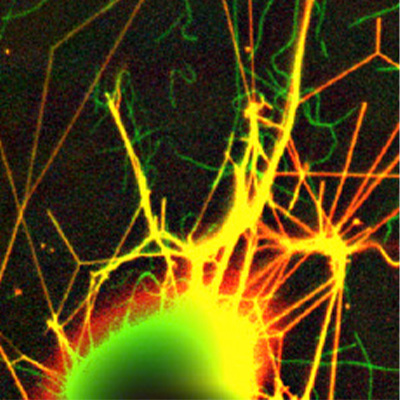
Scientific Achievement: Kinesin, one of nature’s biomolecular machines, is shown to both deform and dynamically reorganize highly-ordered polymer nanostructure networks.
Significance: Creates rapid and continuous assembly of nanostructures, which may enable a new class of self-healing electronic/photonic composite materials. Polymer networks display enhanced stability over lipid networks (24 hours vs. 4-5 hours).
Publication: Paxton, WF, Bouxsein, NF, Henderson, IM, & Bachand, GD., Nanoscale 7, 10998 (2015).

Scientific Achievement: An enhanced electromagnetic field (plasmonic field) couples quantum dots (QDs) together, forming quantum dot molecules.
Significance: Quantum dot molecules form key building blocks for quantum plasmonic devices (such as single-photon transistors) and quantum communication networks.
Publications: Wang, F., Karan, N. S., Nguyen, H. M., Ghosh, Y., Sheehan, C. J., Hollingsworth, J. A., Htoon, H., Small, DOI:10.1002/smll. 201500823, (2015).
Scientific Achievement: Single photons were generated from oxygen-doped carbon nanotubes in SiO2 at room temperature.
Significance: New, doped nanotubes meet requirements for on-demand single-photon sources that function at room temperature and telecommunications wavelengths, requirements that are essential for quantum photonic devices and quantum information processing.
Publications: Ma, X., Hartmann, N. F., Baldwin, J. K. S., Doorn, S. K. & Htoon, H. Nature Nanotechnology, DOI: 10.1038/NNANO.2015.1136 (2015)
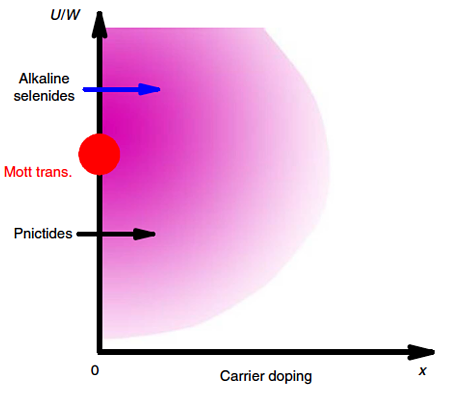
By incoporating the bad metal nature of the normal state, we have provided a unified understanding of superconducting pairing in diverse iron-based superconductors.
Significance: Our study reveals an important principle that superconductivity is optimized at the border between itinerancy and electronic localization. This principle should apply beyond the context of iron pnictides and chalcogenides, and is expected to guide the search for superconductors with even higher transition temperatres.

Strong light-matter coupling between a metamaterial and an intersubband transition in semiconductor heterostructures is fully scalable from the mid-infrared (~10 mm) to the near-infrared (~1.5 mm) and happens on a single nanocavity level in deep sub-wavelength volumes.
Significance: Plasmonic metamaterials offer the possibility to control light in all three dimensions. Here, we experimentally demonstrate strong light-matter coupling between a single nanocavity and intersubband transitions in heterostructures. Such systems show great potential for the realization of electrically tunable optical filters and modulators at any given wavelength or for studying unusual effects such as superradiance.

Observation of Tamm and Defect states in tunable THz plasmonic crystals. Resonant coupling between states on opposite edges of the crystal allowed observation of induced transparency across several crystal periods.
Significance: The engineering of plasmonic resonators in situ rather than solely through lithographic tuning of the physical geometry opens a previously unexplored avenue for the study of strongly coupled electro-magnetic systems.

Non-blinking excitonic emission from near-infrared (NIR) and type-II nanocrystal quantum dots (NQDs) is reported for the first time, coupled with suppressed Auger recombination (AR). To realize this unusual degree of stability at the single-dot level, novel InP/CdS core/shell NQDs were synthesized for a range of shell thicknesses (~1-11 monolayers of CdS).
Significance: This new system demonstrates that electronic structure and shell thickness can be employed together to effect control over key single-dot and ensemble NQD photophysical properties. Suppressed-blinking, NIR emitting NQDs are ideal candidates molecular probes for single-particle tracking; suppressed AR has important implications for optical amplification and lasing.